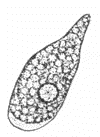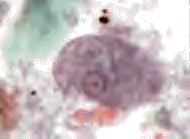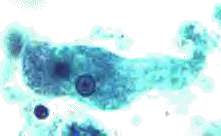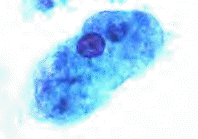-
Trophozoites of Entamoeba
histolytica/dispar.
-
Line drawing (A) and trichrome
stain (B, C, D).
-
Each trophozoite has a single
nucleus, which has a centrally placed karyosome
and uniformly distributed peripheral
chromatin.
-
(This typical appearance
of the nucleus is not always observed:
some trophozoites can have nuclei with an
eccentric karyosome and unevenly
distributed peripheral chromatin.)
-
The cytoplasm has a
granular or "ground-glass"
appearance. Entamoeba
histolytica/dispar trophozoites
measure usually 15 to 20 Ám (range 10 to
60 Ám), tending to be more elongated in
diarrheal stool.
-
(B: specimen contributed by
Dr. Ray Kaplan, SmithKline Beecham, Atlanta, GA.)
-
Courtesy of the Division of
Parasitic Diseases at the National Center for
Infectious Diseases, Centers for Disease Control
and Prevension (public domain)
-
http://www.dpd.cdc.gov/DPDx/HTML/Amebiasis.htm
|



